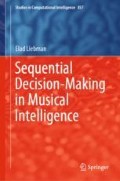Abstract
The purpose of this section is to provide the reader with context helpful for understanding the contributions discussed in this manuscript. Whereas a fuller review of the (extensive) literature lying at the intersection of AI and music is provided in Chap. 8, in this chapter I focus on the key frameworks utilized in this book. In Sect. 2.1 I present the key learning framework used in this work, which is reinforcement learning. In Sect. 2.2 I provide a broad overview of music AI research, with a particular focus music recommendation, which is a recurring theme in this book (particularly in Chaps. 3 and 4, but also relevant to Chap. 7), and on the gaps this book aims to address. Because human behavior with respect to music is another key aspect of this book (particularly in Chaps. 3, 5, and 6), in Sect. 2.3 I provide context relating to the impact of music on human behavior, and discuss how this book addresses gaps in this respect as well.
Access this chapter
Tax calculation will be finalised at checkout
Purchases are for personal use only
Notes
- 1.
If the states are not fully revealed to the agent, then the problem becomes a Partially Observable MDP (or POMDP). Though many real world problems can be modeled more accurately as POMDPs rather than regular MDPs, this distinction is beyond the scope of this book.
References
R.S. Sutton, A.G. Barto, Reinforcement Learning: An Introduction (MIT Press, 2018)
R.S. Sutton, D.A. McAllester, S.P. Singh, Y. Mansour, Policy gradient methods for reinforcement learning with function approximation, in Advances in Neural Information Processing Systems (2000), pp. 1057–1063
P. MacAlpine, S. Barrett, D. Urieli, V. Vu, P. Stone, Design and optimization of an omnidirectional humanoid walk: a winning approach at the RoboCup, 3D simulation competition. AAA I, 2012 (2011)
D. Silver, G. Lever, N. Heess, T. Degris, D. Wierstra, M. Riedmiller, Deterministic policy gradient algorithms, in ICML (2014)
V.R. Konda, J.N. Tsitsiklis, Actor-critic algorithms, in Advances in Neural Information Processing Systems (2000), pp. 1008–1014
J. Schulman, F. Wolski, P. Dhariwal, A. Radford, O. Klimov, Proximal policy optimization algorithms. arXiv:1707.06347 (2017)
G. Tzanetakis, F. Cook, A framework for audio analysis based on classification and temporal segmentation, in Proceedings. 25th EUROMICRO Conference, 1999, vol. 2 (IEEE, 1999), pp. 61–67
G. Tzanetakis, P. Cook, Musical genre classification of audio signals. IEEE Trans. Speech Audio Process. 10(5), 293–302 (2002)
T. Blackwell, Swarm music: improvised music with multi-swarms, Artificial Intelligence and the Simulation of Behaviour, University of Wales (2003)
G. Bickerman, S. Bosley, P. Swire, R.M. Keller, Learning to create jazz melodies using deep belief nets (2010)
I. Liu, B. Ramakrishnan, Bach in 2014: music composition with recurrent neural network. arXiv:abs/1412.3191 (2014)
B. Sarwar, G. Karypis, J. Konstan, J. Riedl, Item-based collaborative filtering recommendation algorithms, in Proceedings of the 10th International Conference on World Wide Web (ACM, 2001), pp. 285–295
H. Morita, S. Hashimoto, S. Ohteru, A computer music system that follows a human conductor. Computer 24(7), 44–53 (1991)
Author information
Authors and Affiliations
Corresponding author
Rights and permissions
Copyright information
© 2020 Springer Nature Switzerland AG
About this chapter
Cite this chapter
Liebman, E. (2020). Background. In: Sequential Decision-Making in Musical Intelligence. Studies in Computational Intelligence, vol 857. Springer, Cham. https://doi.org/10.1007/978-3-030-30519-2_2
Download citation
DOI: https://doi.org/10.1007/978-3-030-30519-2_2
Published:
Publisher Name: Springer, Cham
Print ISBN: 978-3-030-30518-5
Online ISBN: 978-3-030-30519-2
eBook Packages: Intelligent Technologies and RoboticsIntelligent Technologies and Robotics (R0)

